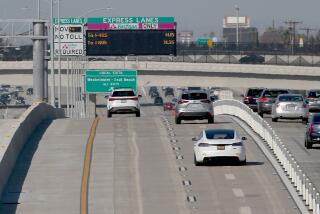Toting Up Pluses and Minuses, Ins and Outs of Car-Pool Lanes
- Share via
Your disparaging editorial comment (“All in the Car Pool,” Sept. 14) on the proposal to open the car-pool lanes off peak hours to all drivers shows a surprising lack of understanding of how these things do and do not work.
The proposal is not a “sop” to anybody, but a realistic recognition of the fact that there are losses as well as gains in a car-pool lane. The gain, of course, is cars removed from the road by new car pools formed on account of the lane incentive. The loss is the under-utilization that has to occur in order to preserve the free-flow incentive.
Our data on the Costa Mesa Freeway show that this loss is larger than the gain resulting in a net loss of person capacity and increased congestion and pollution for all hours. But the net loss is commonly greatest and most obvious during the off-peak hours when the car-pool lane is significantly under-utilized, and yet the mixed-flow lanes are still badly congested. Opening the car-pool lanes to all would result in the largest reductions of congestion, lost time, pollution and accidents.
In a recent survey by the Department of Transportation, the overwhelming majority of car-pool lane management agencies (17 out of 22 nationally, including San Francisco) already understand this and open the car-pool lanes to all traffic in the off-peak hours.
Drivers for Highway Safety supports the proposal because it will result in a demonstrable reduction in overall, 24-hour congestion, lost time, fuel usage, pollution and accidents. We would hope that reasonable persons would agree that those should be the bottom-line objectives.
CHRIS EMA
Drivers for Highway Safety
More to Read
Sign up for Essential California
The most important California stories and recommendations in your inbox every morning.
You may occasionally receive promotional content from the Los Angeles Times.













